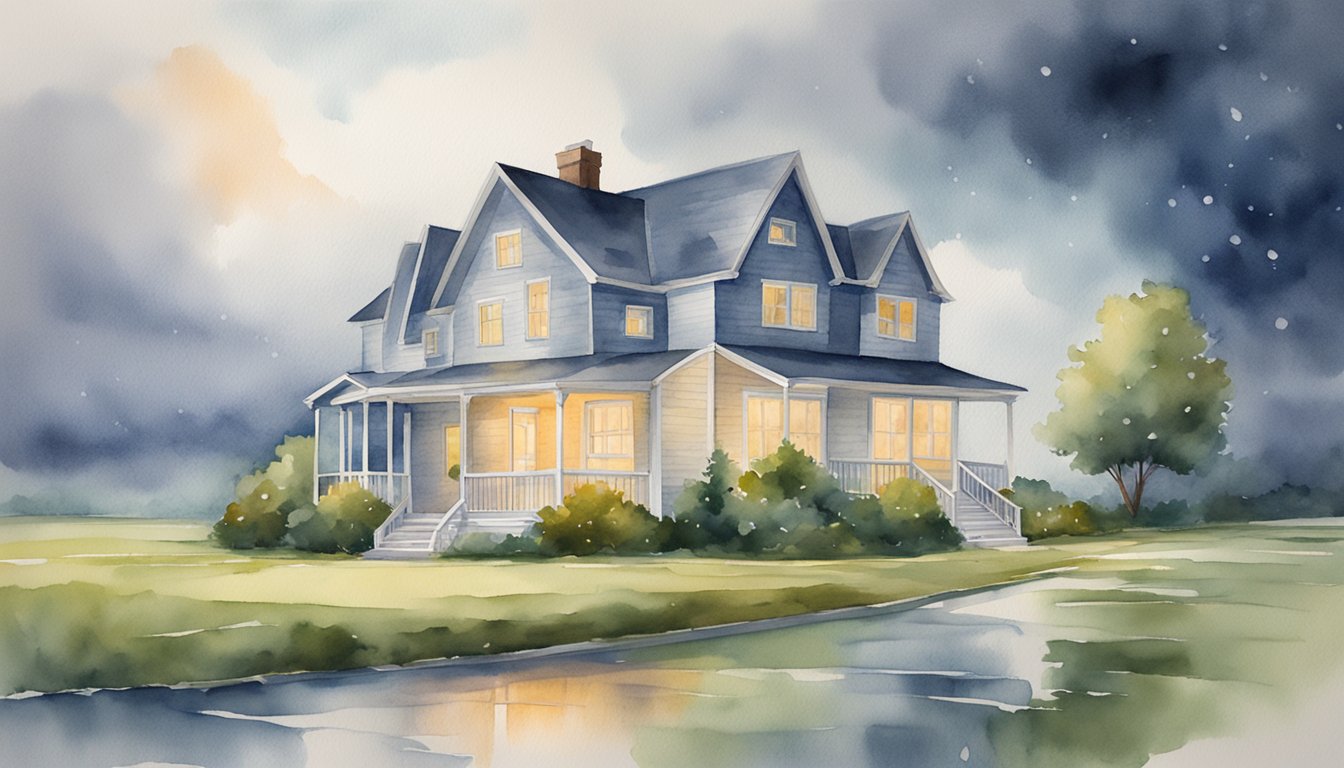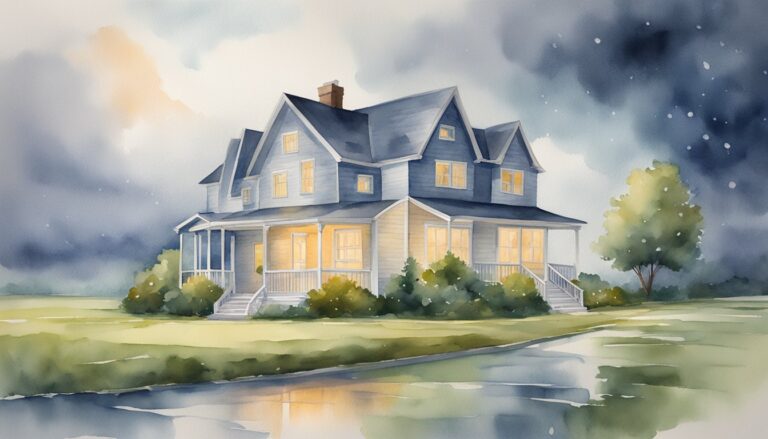Understanding Homeowners Insurance
Homeowners insurance is essential for protecting your house and belongings from unexpected events like fires, theft, and natural disasters.
It typically includes several types of coverage.
Dwelling Coverage: This part of your homeowners insurance policy pays for repairs if your house is damaged by a covered event.
Personal Property Coverage: This covers your personal belongings, such as furniture and electronics, up to a certain limit.
Policies usually set coverage at 50% to 70% of the dwelling amount.
Discover more about personal property.
Liability Coverage: If someone gets injured on your property or you cause damage to someone else’s property, liability coverage helps cover legal costs and damages.
Loss of Use: If your home is uninhabitable due to damage, this coverage pays for additional living expenses.
Learn about loss of use.
Many insurers like State Farm, USAA, Chubb, and Nationwide offer these coverage options.
The cost of your home insurance depends on factors like location, home value, and coverage limits.
According to a Forbes analysis, the national average cost for home insurance is $2,110 per year for $300,000 in dwelling coverage.
When choosing a policy, consider additional options like higher liability limits or broader personal property coverage.
It’s essential to compare quotes from different home insurance companies to find the best deal.
Seek advice from a broker or directly from insurers, and pay attention to customer service reviews from companies like American Family.
For more information, explore definitions like market value to better understand your policy.
Choose coverage that best suits your needs and provides comprehensive protection.
Managing Risks and Protecting Assets

Homeowners insurance is essential to safeguard your house and belongings.
It offers various forms of coverage like protecting personal property, liability, and extended replacement cost.
You should consider personal property coverage to protect items like furniture, art, and appliances.
This includes protection against risks such as theft and water damage.
Liability coverage is crucial for protecting yourself against legal claims.
If someone gets injured on your property or if you accidentally cause property damage to others, this coverage helps cover the costs. Personal injury protection is another important aspect that can assist with medical expenses from injuries.
Extended replacement cost coverage ensures your home is rebuilt to its original state, even if the costs exceed the policy’s limit.
This is different from guaranteed replacement cost coverage, which guarantees full cost coverage without a cap.
High-value items like jewelry might need additional coverage.
Adding a rider to your policy can provide extra protection beyond the standard limits.
Natural disasters and perils such as earthquakes and floods may require specific types of insurance.
For instance, having earthquake insurance or flood insurance can keep you protected against these events.
In the event of a catastrophic loss, understanding your insurance terms can be beneficial.
For example, knowing the difference between actual cash value and replacement cost can affect your claims payout.
To sum up, adequately managing risks with proper insurance helps you protect your assets, maintain peace of mind, and secure your financial future.
Exploring Additional Coverage and Savings
Homeowners insurance offers various ways to protect your home and belongings.
Understanding additional coverage options can help you save money and provide better protection.
Dwelling Coverage: This covers the structure of your home.
If you experience fire damages or damage from falling trees, dwelling coverage helps pay for repairs.
This can include roof, walls, and floors.
Personal Belongings: This covers items like clothing, electronics, and furniture.
If you have expensive items, consider adding coverage for those.
Additional Coverage Types
- Fire: Covers loss from fire damages.
- Flood Insurance: Essential for locations prone to flooding.
- Liability Limits: Protects you if someone gets injured on your property.
- Medical Bills: Covers medical expenses if someone gets hurt on your property.
Discounts
Getting discounts can lower your premium.
Installing protective devices like burglar alarms can give you home insurance discounts.
Similarly, bundling home and car insurance can offer further savings.
Ways to Save
- Increase Deductibles: Raising your deductible can lower your premium.
- Ask About Discounts: Always ask insurers about available discounts to maximize savings.
- Compare Quotes: Shop around for home insurance quotes to find the best rates.
Other Considerations
Loss of Use: Covers additional living expenses if your home becomes uninhabitable.
Wear and Tear: Regular maintenance can prevent issues that aren’t covered.
Location: Your location can affect your insurance price.
Areas prone to natural disasters might have higher premiums.
Emergencies
In case of emergencies like fire or hail, having the right coverage ensures that you and your family are protected against high costs.
Always check your policy’s details to know what’s included and what’s not.
Frequently Asked Questions

Understanding homeowners insurance can help you make better decisions about your coverage.
This section addresses common concerns, pricing factors, and strategies to manage premiums.
What factors influence the pricing of homeowners insurance policies?
Several elements determine the cost of homeowners insurance.
Your home’s location, age, and construction materials are significant.
Additional factors include your credit score, claim history, and the coverage amounts you choose.
How can one accurately compare quotes from different homeowners insurance providers?
To compare quotes effectively, make sure the coverage levels and deductibles are similar.
Review the terms, exclusions, and claim limits.
It helps to check customer reviews and financial stability of insurance companies to ensure you choose a reliable provider.
What are the typical coverages included in homeowners insurance?
Homeowners insurance often covers damage to your house and belongings due to events like fires or storms.
It also includes liability coverage in case someone gets injured on your property.
Loss of use coverage helps with living expenses if you’re temporarily displaced from your home.
How does geography impact homeowners insurance rates?
Your location greatly affects rates.
Homes in areas prone to natural disasters like floods, earthquakes, or hurricanes have higher premiums.
Local crime rates and the availability of local fire protection services also play a role in determining costs.
What are the typical steps to file a homeowners insurance claim?
First, contact your insurance company immediately to report the incident.
Document the damage with photos and videos, and keep receipts for any expenses.
An adjuster will visit to assess the damage.
Be honest and thorough during this process to avoid issues like insurance fraud.
What strategies can homeowners use to lower their insurance premiums?
To lower your premiums, consider increasing your deductible.
Install safety features like smoke detectors and security systems.
Maintaining a good credit score and bundling multiple policies, like auto and home insurance, with the same provider can also lead to discounts.






